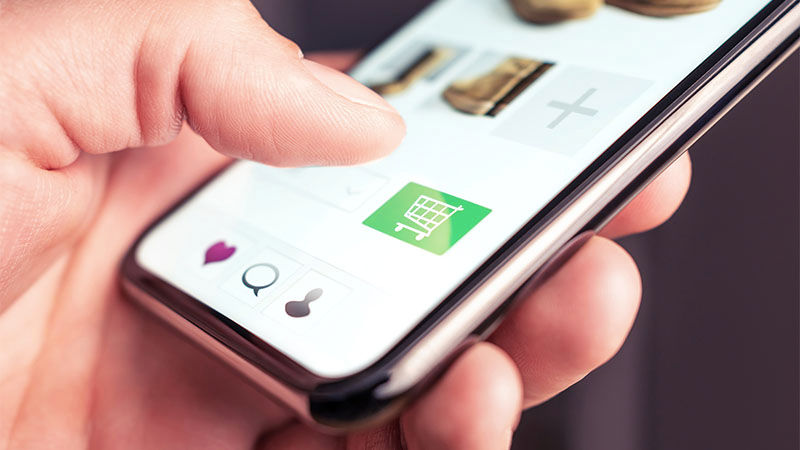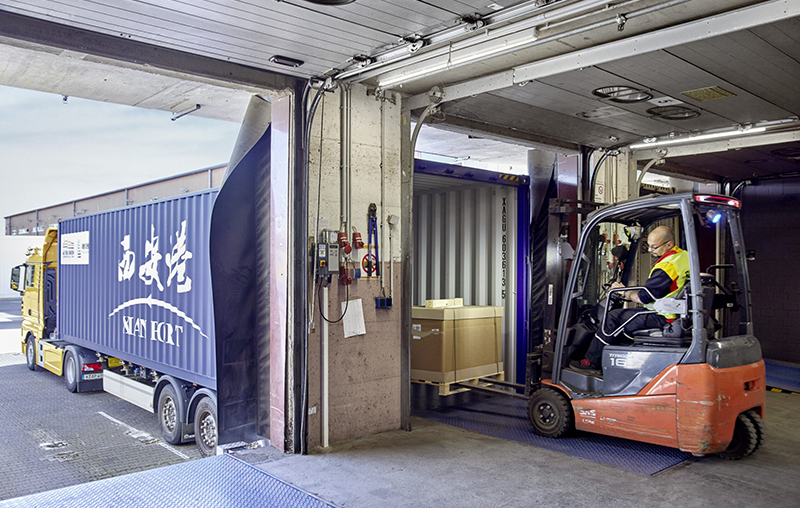E-commerce is changing all the time. To help you keep up with the changes, we have picked out 15 of the latest e-commerce trends, with insights, data, and some suggested next steps, to help you make the most of those that are relevant to your business. But first, let’s put these trends into context by taking a look at the e-commerce landscape.
The current e-commerce landscape
The global pandemic accelerated the shift from physical retail to e-commerce. According to Forbes1, in 2023, 20.8% of global retail purchases are expected to take place online.
Competition within the e-commerce sector has never been fiercer, so, to stay ahead, business owners need to be aware of the latest trends in e-commerce and integrate those that are relevant into their growth strategy.
1. AR and VR enhance online shopping
One of the biggest emerging trends in e-commerce is the use of Augmented Reality and Virtual Reality to enhance the online shopping experience.
AR integrates the real, physical world with computer-generated visuals, sound or both. VR puts the user in a computer-generated, but seemingly real, environment using a VR headset.
AR and VR can give customers a far more realistic idea of what a product is actually like – for example, how an item of clothing fits or how a shade of paint looks on a wall in a room. If the technologies are adopted as widely as some experts predict, shoppers will have even less reason to visit bricks-and-mortar stores.
Tessa Wuertz, Director of Marketing & Partnerships at efelle.com, predicts small and medium-sized businesses will increasingly use AR:
“We are expecting a lot more businesses to utilize AR for their products and businesses — so much so that it will become more standard in e-commerce and social media platforms. We’re seeing it put to use with larger companies, but I think we’re soon going to start seeing it become mainstream for businesses of all sizes.”2
Next step
- Integrating AR features within your brand’s website or app will give your customers a better idea of the products they’re buying – and in turn, reduce your returns rate.
2. Voice search and visual search will both grow
Voice search is a fast-growing online shopping trend. Nearly half (47%) of shoppers have used voice command technology to make an online purchase and 58% were satisfied with the experience3.
Smart e-commerce business owners will need to optimize their e-commerce stores for voice search on Google, using keywords and phrases.
Visual search – allowing consumers to carry out searches using images – is a less developed e-commerce trend, with only 8% of brands offering it currently. However, with 62% of Millennials and Gen Z wanting to use visual search, it’s only a matter of time before it becomes mainstream.
Next steps
- Use a semantic strategy instead of a keyword based strategy – semantic SEO will ensure your voice search technology recognizes the more natural way your customers search with speech than if they were typing.
3. AI will collect even more data
Online customers have come to expect truly personalized experiences online – and that is where the new generation of AI-powered technologies is transformative. It can understand customer behavioral data on a deeper level to help businesses increase customer engagement and conversion rates.
Next steps
The opportunities AI affords to e-commerce businesses are endless, but some of the ways it can improve operations include:
- Based on previous browsing history data, AI can help businesses deliver highly personalized product recommendations to customers
- AI can improve written and visual content – like product descriptions – to be more accurate and impactful
- AI-powered chatbots can track previous customer conversations to find them a solution quicker
4. On-site shopping will be more personalized – or not
Data collected by AI allows businesses to deliver customers personalized experiences when shopping online – such as tailored product recommendations. This incentivizes shoppers to complete the purchase.
However, consumers are increasingly resistant to sharing their data. This will be especially true when that personalization expands out of shopping platforms and begins to appear elsewhere, on other gadgets in the home, thanks to the Internet of Things.
Next steps
- Use your customers’ past purchasing history to send them deals and discounts on related products.
- Be sure to flag your data privacy policy whenever you ask customers for information.
5. Returns remain a dilemma
Research shows that free returns are a huge draw for consumers, yet around 30% of all online orders are returned, making it an expensive feature for businesses to offer.
One of the emerging e-commerce trends is businesses charging a fee for returns – with retail giants like Zara and Uniqlo introducing the policy last year. So, what should your business do?
Next steps
- You could offer free returns to your customers for a trial period to assess whether the increased sales eclipse the cost to your business.
- Prevention is better than cure – look to reduce your returns rate in the first place with these tips.
6. Chatbots will be everywhere
Chatbots will increasingly be used for customer support in e-commerce, with the global market expected to be worth US$3.99 billion by 20304.
As the e-commerce market becomes ever more competitive, efficient customer service from a chatbot can be the difference between a frustrated customer leaving your webstore to shop elsewhere, and staying to make a purchase.
The most sophisticated chatbots can even use a customer’s previous data to anticipate which products will appeal to them or suggest a product that complements a recent purchase – boosting sales further.
Next step
- Discover exactly how chatbots could transform your business’s sales with our deep dive into this innovative technology. Be inspired, here.
7. M-commerce will continue growing
Mobile commerce, or m-commerce, can be defined as the buying and selling of goods and services using wireless handheld devices, such as smartphones and tablets. Customers can shop anytime, anywhere – meaning lucrative opportunities for your business.
According to Statista5, smartphone retail commerce sales are projected to top US$400 billion by 2024, nearly double the amount forecast for 2021.
Next steps
- Ensure your current website is optimized for mobile.
- Even better, invest in a dedicated mobile app for your business – conversion rates through mobile apps are 130% higher compared to mobile-first websites.
8. Social selling is growing too
With more and more social platforms enabling consumers to buy directly from businesses without leaving the app, social sales are expected to triple to US$1.2 trillion by 2025, according to a study by Accenture7.
For smaller e-commerce businesses in particular, social media commerce represents a cost-effective sales route.
Next steps
- Many people use social media to research brands before buying, so ensure your feeds have lots of product information and high-definition photos. Be sure to reply to followers’ questions quickly.
- Add in-app shopping features to your social media channels to make it easy for customers to buy from your brand.
- If you’re exploring influencer marketing, focus on follower engagement rather than just follower numbers.
9. More payment options
Online payment solutions are constantly evolving, with “Buy Now Pay Later” services currently in the spotlight. These allow online customers to pay for their purchases in installments, and is offered by companies such as Klarna, PayPal and Afterpay. According to Mastercard, which has recently introduced Mastercard Installments, it reduces online cart abandonment rates by 35%8.
Next steps
- Online shoppers are 70% more likely to finalize a purchase if their preferred payment method is displayed as an option at checkout, so offer lots of choice – these are the ones to consider.
- If you sell to international customers, be sure to research local payment preferences. Our Country Guides have the insights you need.
10. More businesses will switch to headless commerce
In a recent survey by Salesforce9, 80% of business leaders said they plan to switch to headless commerce. So, what is it and why is it one of the most popular e-commerce trends?
Put simply, headless commerce is a next generation e-commerce solution that decouples a website or application’s front and back ends. It uses application programming interfaces (APIs) to deliver content to any front-end framework.
As a result, customers will be able to shop online via Internet of Things (IoT) devices such as smart speakers, smart fitness devices, or even smart fridges – not just the usual PCs, laptops and smartphones. By bringing together all these online shopping routes, headless commerce increases flexibility, and adds new sales opportunities. And because it can quickly incorporate new sales channels, it can also streamline omnichannel selling.
All these benefits will make headless commerce one of the most future-proof trends in e-commerce.
Next step
- For small businesses, adding an API to their existing commerce platform is a good first step into headless commerce. Via this, they can customize their front-end to create the exact look and feel of their brand.
11. The continued importance of video marketing
Video can give customers a much better picture of a product than even the most detailed description, so it’s no wonder it’s a growing trend in online shopping.
You can use video to show the size of a product, how it works, and how it looks. And the more a customer knows about a product before buying, the less likely they are to return it – saving you money in the long run.
Next step
- Experiment with video across your social media channels – customer testimonials and “how to” guides are great for engaging your audience.
12. Subscriptions
Online subscriptions meet the need for both customer convenience and predictable, regular revenue for businesses.
Subscriptions can be used for everything from streaming services like Netflix, to regular deliveries of food and other essentials. The model is also growing in popularity amongst Millennials, so it looks like it’s here to stay. In fact, it’s expected to be worth $2419.69 billion10 by 2028.
Next steps
- Customers love a deal – they’ll only join your subscription service if it works out as cheaper than buying ad hoc, so be prepared to offer discounts.
- Create a sense of community by giving special treats to members – like a discount code on their birthday.
13. Sustainability is now essential
Eco-conscious consumers are increasingly choosing to shop with sustainable brands. As well as minimizing packaging and using recycled materials for your products wherever possible, you need to be mindful of who you choose as a logistics partner.
Next step
- Talk to DHL! The logistics leader has set itself the ambitious goal of zero emisssions by 2050 – and has hit many of its targets early along the way. Discover which of its GoGreen services – from climate neutral shipping to carbon offsetting – is right for your business, here.
14. Optimizing for conversion
In an economic climate where people are spending less, it’s vital to convert visitors to your webshop into purchasers. Using conversion rate optimization (CRO) tools can help you achieve this. They include behavior analytics tools, web analytics tools and CRO testing tools.
According to Verfacto10, the average return on investment of using CRO tools is more than 223%. Using the right combination will help you provide the very best user experience and convert traffic into sales.
Next step
- Look into CRO tools such as Hotjar and Glassbox for qualitiative data analysis, and Google Analytics or Mixpanel for quantitative data.
15. The continued growth of B2B e-commerce
Alongside B2C e-commerce, B2B e-commerce was also boosted by COVID, as traditional B2B transactions were forced online. Furthermore, the change is being driven by an increase in Millennials in key B2B decision-making roles. This generation, which has grown up with the internet, prefers to research products online to dealing with sales people over the phone or in person. All things considered, the growth of B2B appears to be an e-commerce trend that will accelerate rather than reverse.
Next step
- Download Discover’s exclusive guide to B2B e-commerce to maximize every opportunity this emerging sector has to offer.
Deciding which e-commerce trends to follow
Of course, not all the trends discussed above will be relevant to your business, but there are a few good indicators you can follow. For a start, keep a close eye on what’s being talked about in your industry. If a respected industry blogger is writing about one of the trends, it’s probably worth looking into it further. Likewise, make sure you’re up-to-date with the latest research and industry trend reports.
Another good indicator is your own customers. Use analytics to track their behavior and gain insights. By using the data, you may well be able to decide whether a particular online shopping trend will work for your customers. And of course, you can always ask them directly for feedback – always a good source of insights.
Finally, look at your competitors. What are they doing and is it working for them? Then draw your own conclusions.




























